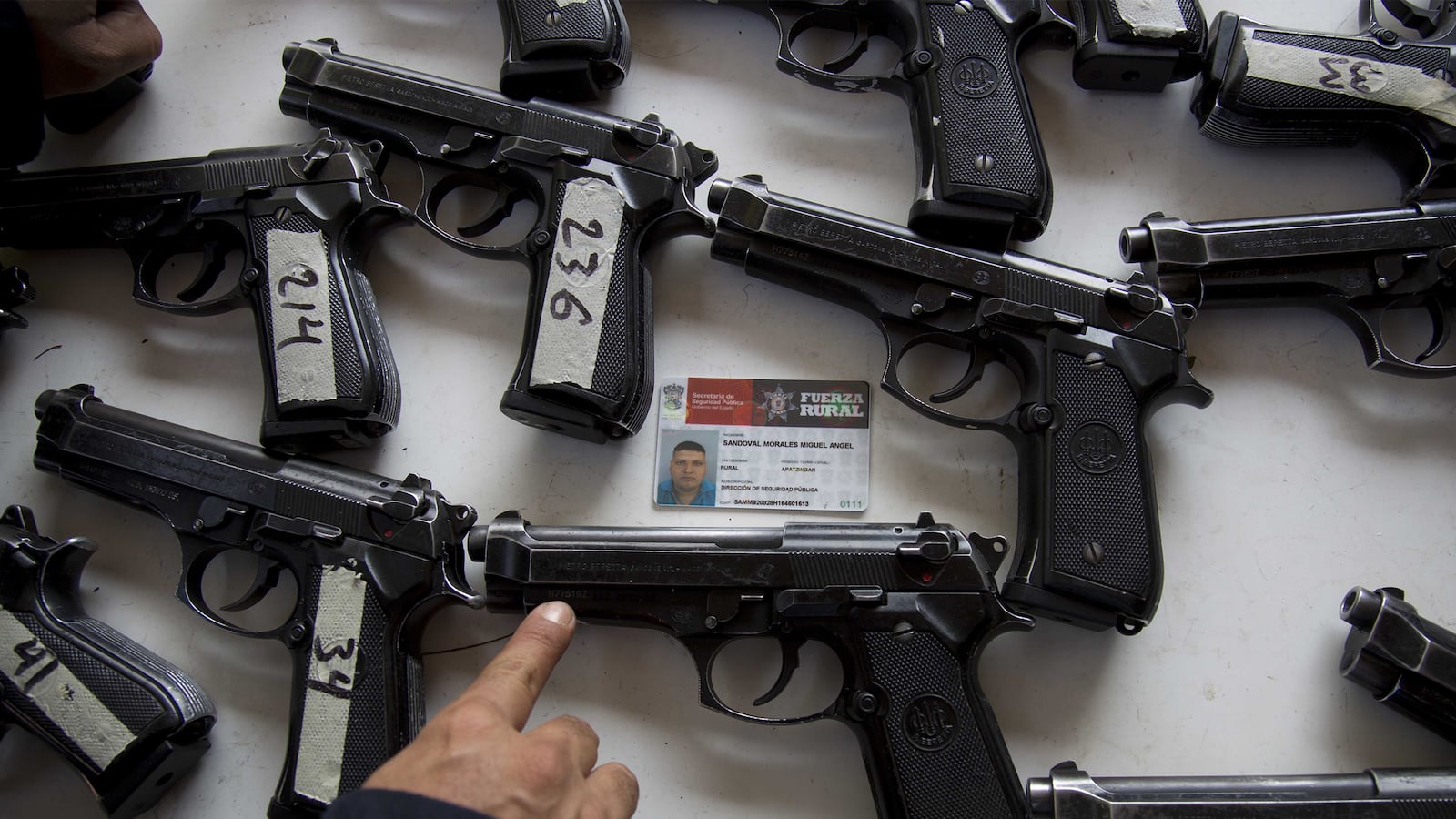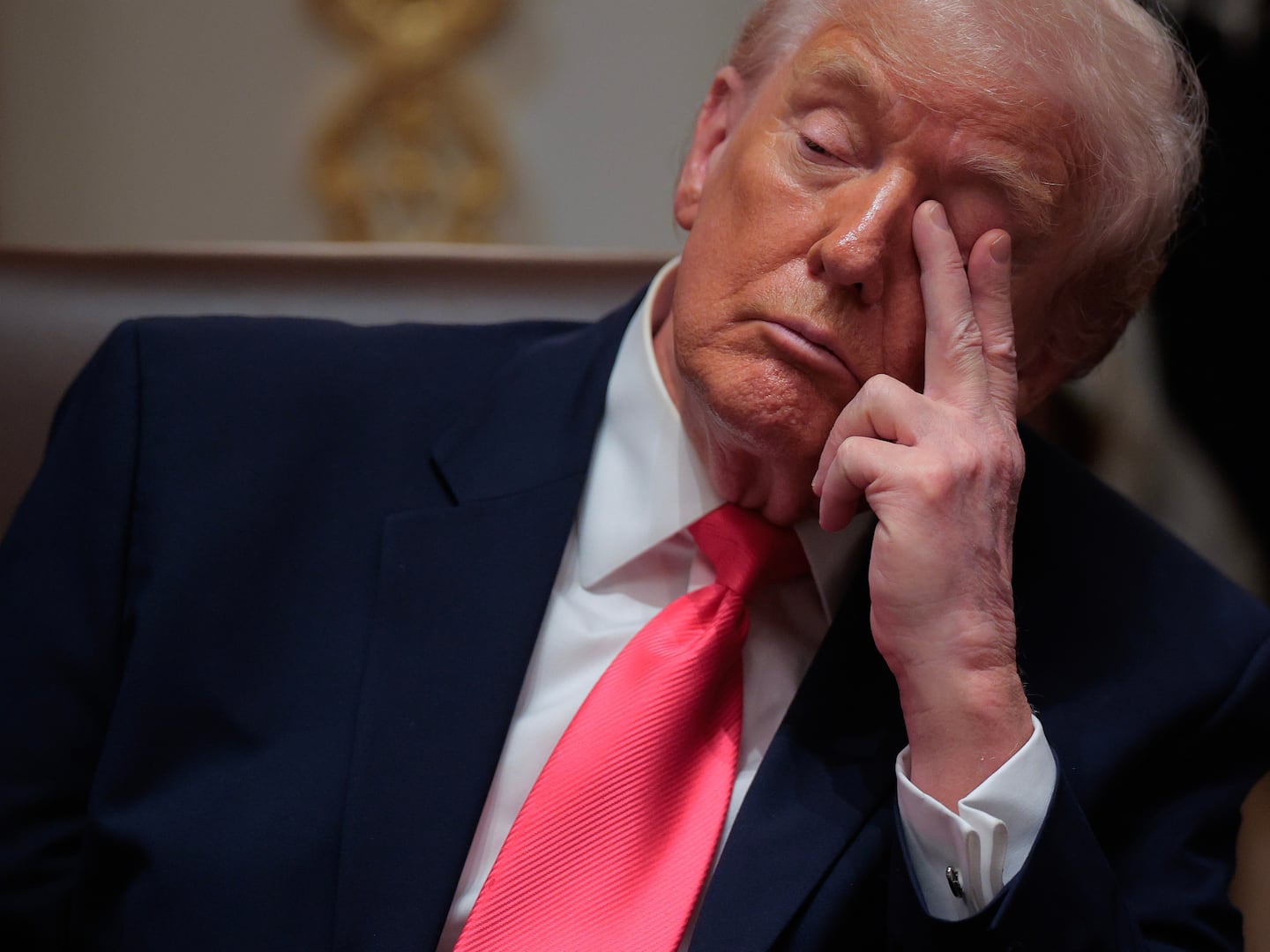TIERRA CALIENTE, Mexico — This is what a cartel-besieged town looks like: shuttered storefronts, crumbling buildings, and streets that empty each day at dusk.
Welcome to Tepalcatepec, where the average local temperature is 95 degrees and the chief local export is crystal meth. According to the regional press, this ramshackle pueblo is the No. 1 drug distribution center for the entire state of Michoacán.
Like a growing number of other cities and towns across western Mexico, Tepalcatepec is in danger of succumbing to the nation’s newest mega-mafia: the Jalisco New Generation Cartel (CJNG).
The CJNG isn’t just super-sized. It’s also ruthless and hyper-violent, even by Mexican cartel standards. Back in 2011 the group slaughtered 35 members of a rival gang, including 12 women, and dumped the bodies on an interstate highway at rush hour. And that was just a warm-up act.
Over the last year, the CJNG has become known for taking the fight to law enforcement—launching guerrilla-like assaults against authorities that have claimed dozens of officers’ lives, including shooting down an army helicopter and killing everyone aboard.
Situated on the border between the states of Jalisco and Michoacán and at the crossroads of two major highways, Tepalcatapec offers a vital control point for the CJNG. From here they can launch attacks against competing crime networks in Michoacán, as well as packing and processing drugs to send them north.
“The cartel is trying to penetrate the community and take over the whole town,” says Juventino Cisneros, the state police chief of Tepeque (as locals call the town), when we meet in his command bunker—a squat, thick-walled building that also houses the precinct armory.
“The [CJNG] wants to control the black market here—to cook drugs, extort business owners, kidnap and kill people,” says Cisneros, 56, a former vigilante whose eldest son was murdered during a botched abduction attempt a few years ago.
Tepeque sits at the head of the long, cactus-covered valley called Tierra Caliente, which acts like a funnel for drugs flowing down from the mountains on both sides. Tierra Caliente was once under the control of the gruesome Knights Templar cartel—but since the Knights’ defeat by vigilantes like Cisneros, in 2014, the CJNG has moved in to fill the vacuum.
“We still outnumber them—for now,” Chief Cisneros says. “But we don’t know how much longer we can keep them out.”
Keeping the CJNG at bay also poses a stiff challenge for American law enforcement.
In an email to The Daily Beast, DEA agent Russ Baer calls the CJNG “one of the most powerful [cartels] in Mexico” that also “operate[s] cells within the U.S.”
The U.S. Treasury Department has designated the super cartel’s leader, Nemesio Oseguera Cervantes (alias “El Mencho,” or “Blondie”), a “Narcotics Kingpin”—and the State Department is offering up to $5 million for information leading to his capture and conviction.
The de facto successor to the Sinaloa Cartel’s Chapo Guzmán, El Mencho, who is in his mid to late forties, has been trafficking narcotics across the U.S.-Mexico border for more than two decades.
He was convicted of selling heroin by the U.S. District Court of Northern California in 1994, says Baer, but was released after serving almost three years in prison.
Founded by El Mencho in 2009, “the CJNG [has] rapidly expanded their criminal empire in recent years through the use of violence and corruption,” Baer says. That growth pattern includes stepped up incursions onto American soil, “with [U.S.] law enforcement increasingly reporting CJNG members and associates as sources of supply for drugs.”
As part of their expansion efforts, the Jalisco Cartel is now making forays into Tijuana on the California border. The CJNG’s attempted takeover has already sparked a bloody turf war with the Sinaloa Cartel for control of the city and access to cross-border smuggling routes.
As a result, the murder rate in Baja California has nearly doubled since this time last year, with more than 70 murders occurring in Tijuana in January alone.
Alejandro Hope, a Mexican security analyst with the Washington-based Wilson Center, describes the Tijuana market as “very profitable” for both cartel rivals.
“It’s the best entry point into the West Coast of the U.S.,” said Hope, in an interview with The Daily Beast.
Data provided by DEA agent Baer illustrates just how much drug-based wealth is at stake for the cartels in Tijuana. Narcotics seized in the San Diego smuggling corridor in 2014 (the last year for which statistics are available) amounted to 71,414 kilos and were worth about $230 million.

That quantity likely represents just a fraction of the overall drug shipments flowing in from Tijuana—which is why the desert city less than an hour’s drive from San Diego is being so hotly contested by the two crime families.
The CJNG was once a regional faction of the Sinaloan cartel—but Chapo’s capture in early January weakened that crime group. As their rivals’ power was on the wane, the Jalisco Cartel has been “growing by leaps and bounds over the last five years,” says Hope, who attributes much of the group’s success to El Mencho Osegueras’s “bold” style of leadership.
Growth isn’t the only difference between the two syndicates, according to Raúl Benitez, an organized crime expert at the National Autonomous University (UNAM).
“The Jalisco Cartel is notoriously violent,” Benitez tells The Daily Beast, whereas “the Sinaloans are more negotiators” who rely on bribes and coercion to maintain influence. The disparity in tactics could lead to the CJNG “winning Tijuana,” Benitez says.
“The only thing worse than a border town’s criminality under the firm control of an organized crime group, is a [border town] in dispute between two or more organized crime groups,” Adam Isacson of the Washington Office on Latin America told The Daily Beast in an email.
“Homicides spike upward. People flee. Businesses shut down. U.S. citizens stop visiting. And the amount of smuggled drugs and migrants doesn’t appear to change.”
Even if violence doesn’t spill over the border, says Isacson, “life on the U.S. side is still altered by the fear and economic depression on the Mexican side.”

Back in Tepeque, in El Mencho’s home state of Michoacán, there’s plenty of fear and economic depression to go around.
Claims that the state government is on the CJNG’s payroll abound in Michoacán, where politicians have a long history of taking crime lords as their bedfellows—and many observers, including sources in the criminal underworld, say such alliances are still the norm.
Whether it’s bureaucratic incompetence, or something more sinister, there’s no question that the local government has done very little to stem CJNG’s infiltration into Michoacán.
“The government in [the state capital of] Morelia has no idea what we’re up against here,” says Tepeque Police Chief Cisneros, who was an early leader of the vigilante movement that ousted the previous alpha-dog cartel.
“If the politicians let us, we could do to the Jalisco Cartel what we did to the Templarios [Templars] in a matter of months,” Cisneros says. The main obstacle for local law enforcement, according to the former rancher turned crime fighter, is a lack of funding from the state.
“We have to buy our own vehicles, gasoline, uniforms, even bullets,” says Cisneros. And the salaries allocated for officers are to “next to nothing.”
“It’s the government’s responsibility to protect the community—but they don’t do a thing,” the chief says, as he reaches for a pack of Marlboro Reds in his shirt pocket.
“The cartel has all their illicit funds to spend on high-tech weapons. So how are we supposed to fight them off when we’re broke?”

Mexican authorities have learned the hard way about the CJNG’s flair for military-grade hardware and tactics.
A series of cartel attacks last spring claimed the lives of 21 police officers in just 20 days.
Then, in May 2015, when Mexican forces tried to push into CJNG territory, the crime group responded by mounting a vicious counterstrike: burning gas stations, blocking roads with flaming semi-trucks, and using an RPG to blow a twin-engine Cougar attack chopper out of the sky, killing eight soldiers and a member of the federal police.
“The cartel uses such displays in order to shock the authorities,” says criminologist Benitez, when asked about El Mencho’s strong-arm tactics. “It’s a way of warning government to back off, and to show them who’s the boss.”
As for high-powered weapons like the shoulder-fired rocket launcher used by cartel gunmen to take down the chopper, Benitez says it was “probably bought on the black market in the U.S.”
There’s “almost no control over arms flowing south from the border,” says UNAM’s Benitez.
And the CJNG has plenty of manpower to go with the easy-to-find firepower. This month authorities in Jalisco stumbled on to a gutsy scheme in which El Mencho’s outfit used a phony security company as a front to bolster its ranks.
“The cartel’s recruiting tactics show how they’re gaining strength, despite how the state government has tried to portray events,” says analyst Hope, who calls the security scam “a very brazen demonstration of impunity” that demonstrates just how easily the CJNG “can operate in the open.”
In another sign of impunity, the Jalisco cartel is alleged to have slain five police officers during two separate attacks in Jalisco state in late February. Those incidents, along with another attempted assassination of a local mayor, prompted some critics to claim the government had lost control of some western portions of the state.
As Hope sees it, the slaying of selected officers is part of the CJNG’s larger struggle to “control police forces in the cartel’s home state.”
Local police, Hope says, “are often a source of cartel muscle.”
“They use the police as an enforcement tool, to collect extortion payments, or carry out abductions and assassinations,” Hope explains. “That way they don’t have to hire so many henchmen.”
The police murdered last month, he theorizes, might well have refused to go along with El Mencho’s marching orders.
“You either accept the cartel’s money,” says Hope, “or you take the bullet.”
The CJNG’s fierce MO has allowed it to gain ground at a time when many other Mexican crime groups are in decline, says security adviser Hope.
Chapo’s capture sapped the Sinaloans. The once-mighty Gulf Cartel has been crippled by factional infighting. Even the fearsome Zetas are in disarray.
The CJNG, on the other hand, is the only Mexican cartel “that has a growth trajectory,” Hope says.
DEA agent Baer agrees.
“CJNG has also further developed its ties to other criminal organizations around the world, including in the U.S., Latin America, Africa, Europe, and Asia,” Baer says. “With additional territory, CJNG has been able to increase its drug trafficking, wealth, and influence.”
For Tepeque Police Chief Cisneros, who lives and works on the front lines of Mexico’s narco war, the stakes of resisting the CJNG couldn’t be higher.
“We’ll do whatever it takes to fight the cartel,” says the chief, who admits he often thinks about the CJNG’s penchant for gunning down officers who won’t go on the drug cartel dole.
“If they come for me,” Cisneros says, invoking the old vigilante oath, “at least I’ll die fighting.”






